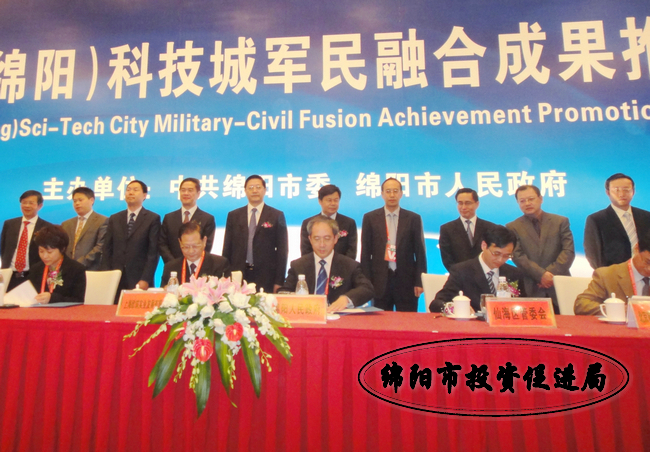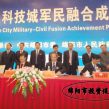
Civil-Military Integration Theme Marks PLA Day Coverage
Publication: China Brief Volume: 11 Issue: 15
By:

The theme for this year’s annual People’s Liberation Army (PLA) Day press was civil-military integration (军民融合) for national defense. If Defense Minister Liang Guanglie’s article “Persevere in Civil-Military Integration with Chinese Characteristics” headlining the Central Party School’s journal Qiushi did not provide enough emphasis, official press broadly addressed a number of themes relating to the need for support from the civilian sector for national defense construction and army building (August 1). Military press analysis of President Hu Jintao’s speech on July 1 noted combat power in the Information Age increasingly depends on civil-military integration, because the distinction between "guns" and "butter" is no longer as sharp a choice as in industrialized or mechanized warfare (PLA Daily, July 7). In this light, the PLA views civil-military integration to be a key feature for how the military intends to resolve its shortcomings.
Every year in honor of the PLA’s founding on August 1, 1927 during the Nanchang Uprising, Chinese military and party press provides authoritative coverage of the PLA’s priorities. In the recent past, PLA Day editorials and press coverage included official promulgation of President Hu’s “New Historic Missions” that established PLA roles beyond China’s periphery (PLA Daily, August 1, 2005). Discussion of civil-military integration is not a new topic; rather, a long-standing subject of People’s War ("Chinese Strategic Thinking: People’s War in the 21st Century," China Brief, March 18, 2010). However, it received only passing mention in last year’s rather generic evaluation of modernization (PLA Daily, August 1, 2010).
While the official PLA Daily editorial covered the entire scope of military modernization, it pointed back to Hu’s speech on July 1. Military affairs arose only once in the speech, but the integration message resounded as Hu exhorted the need to "develop civil-military integration with Chinese characteristics," "make the ideas of rich country and strong army one" and "reinforce and cultivate party-army and civil-military unity" (Xinhua, July 1). Hu’s provided the guidance, but Minister Liang provided the roadmap where the PLA and Chinese society needed to make progress in four categories of civil-military integration: the defense industries and production; national defense education; a joint civil-military security system; and national defense mobilization (Qiushi, August 1).
The first area of integration probably is the most well-known in the West, because the rapid pace of PLA modernization in the last fifteen years spurred several major studies of the Chinese defense industries [1]. According to Liang, building up the industrial capacity to support defense needs under informatized warfare can assist Chinese industry in moving up the value chain, especially in dual-use areas, in support of the 12th Five Year Plan objectives (Qiushi, August 1). As Academy of Military Science analysts noted earlier this year, the mutual civil-military reliance for technological development in the defense industries can also encourage greater cooperation on education and should be used to do so (Zhongguo Shehui Kexue Bao, May 5).
In terms of national defense education, the PLA continues to emphasize the need to raise the level of education among its officers and non-commissioned officers by reducing its reliance on military academies and trying to pull from the China’s increasingly higher quality civilian universities. In preparing for war under informatized conditions, populating the PLA with high quality personnel is the strategic foundation for national defense. To this end, the Central Military Commission issued a new "Opinion Concerning Improving National Defense Education Work under New Conditions" last month (PLA Daily, July 18; People’s Daily, July 30).
Integrating a civil-military system for the protection of PLA facilities and communications may be one of the largest challenges, because of China’s balkanized governance structure that gives local governments a lot of autonomy ("Growth Imperative Challenges Even Chinese Security Regulations," China Brief, July 29). While military press celebrated a People’s Armed Police unit and a Sichuanese county working with provincial research institutes to develop reconnaissance and communications equipment to serve this mission, the localized development of such equipment makes it more difficult for civil or military authorities to enforce standards (PLA Daily, August 1; Renmin Zhengxie Bao, August 5). This local autonomy allows companies to bid on security contracts without any clear process for screening technology used for sensitive purposes, creating supply chain vulnerabilities (Global Times, July 29). What was not clear was whether PLA leadership is aware of the problems in trying to integrate a slowly homogenizing PLA with wildly different civilian organizations.
National defense mobilization in the context of civil-military integration usually refers to PLA access to civilian resources in wartime; however, the tenor of August 1 press suggests Beijing wants to integrate local military units into society to provide social stability and provide a more organized support base from which the PLA can draw. In Jiaozuo Municipality, a model city for civil-military support, many PLA officers return to assume important posts in the government as the city has made an effort to incorporate demobilized soldiers in the city’s administrative and business life (Guangming Daily, August 1). The People’s Daily ran a feature, “Out of Uniform but Still a Soldier,” about an old war hero who settled into civilian life with the discipline and self-sacrifice that earned him several medals. The hero, Li Wenxiang, according to the article, did not quibble over benefits and rationing, relinquishing his share in times of need, and, as an official, organized people to confront development challenges as though they were battles (August 1). Liang also drew the connection between the reincorporation of PLA soldiers into all walks of life and society’s ability to educate and raise the talent required by the PLA (Qiushi, August 1).
If this year’s PLA Day coverage seems to lack novelty, then it is because the PLA continues along an already determined path. The question is simply how to make the PLA better and the civil-military integration to leverage civilian capabilities for army building is the fastest way to raise the PLA’s capability (PLA Daily, July 7). The PLA’s purpose is set, including missions that address the role of the PLA beyond unification with Taiwan. How the PLA will fight also has been established with integrated joint operations. The problem now facing the PLA is how to address the so-called “two incompatibles" (两个不相适应的主要矛盾), which describe the PLA’s self-assessed inability to win a limited war under informatized conditions and to fulfill the demands of the "New Historic Missions" (PLA Daily, August 1; January 1, 2008; "The Pentagon-PLA Disconnect: China’s Self Assessments of its Military Capabilities," China Brief, July 3, 2008). This year’s PLA Day coverage suggests Chinese leaders, civilian and military, know where development is most needed and that PLA war-fighting capability will reflect developments within the society writ large. Unanswered however were two questions about civil-military integration posed by Jiang Luming: what is the appropriate level of integration for the civilian and military economies and what is the appropriate level of investment (Study Times, January 4).
Notes:
1. For example, Roger Cliff, Chad Ohlandt, and David Yang, Ready for Takeoff: China’s Advancing Aerospace Industry, Santa Monica, CA: RAND, 2011; Tai Ming Cheung, Fortifying China: The Struggle to Build a Modern Defense Economy, Ithaca, NY: Cornell University Press, 2009; and Evan Medeiros, Roger Cliff, Keith Crane, and James Mulvenon, A New Direction for China’s Defense Industry, Santa Monica, CA: RAND, 2005.





